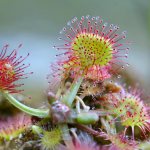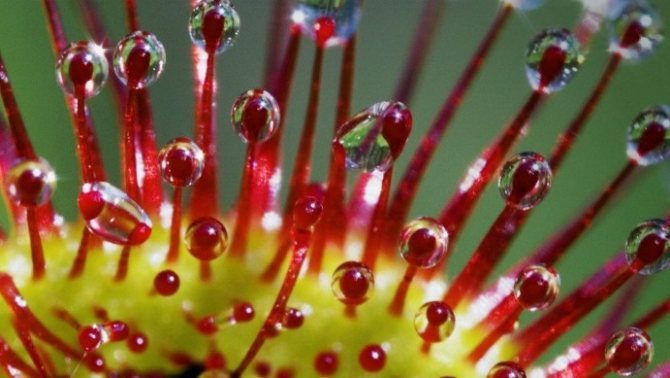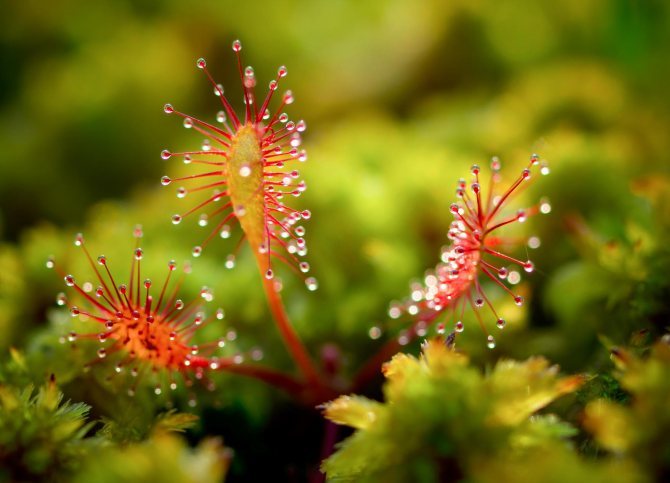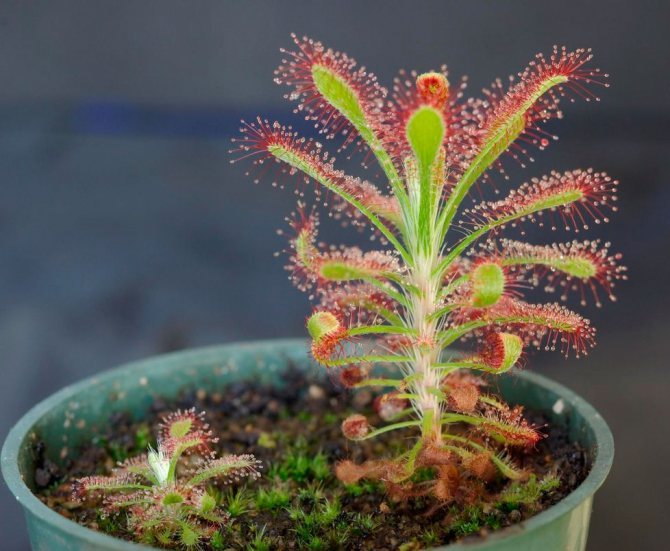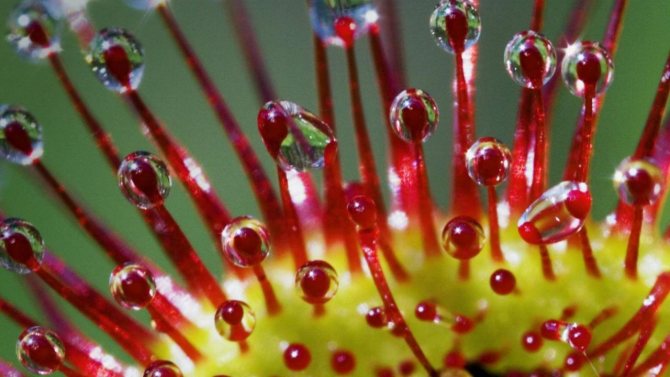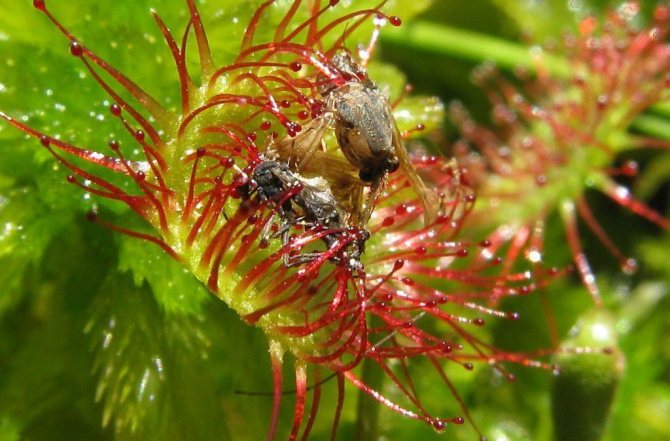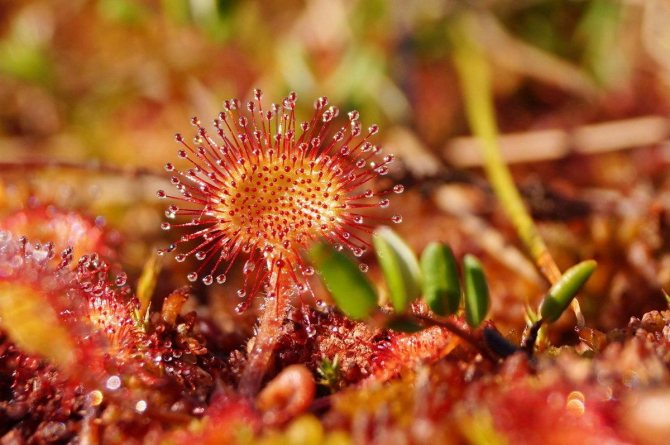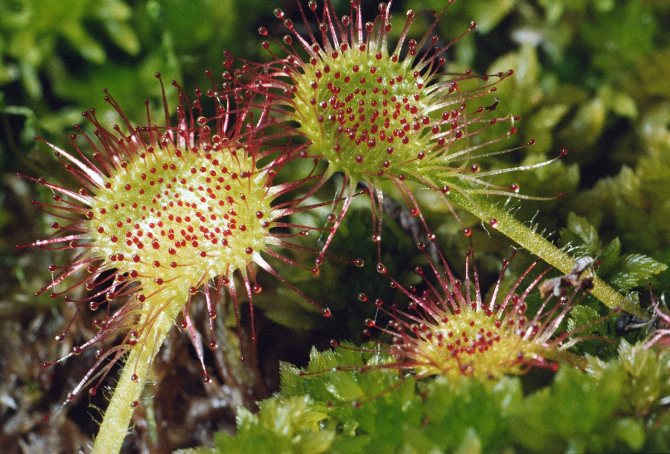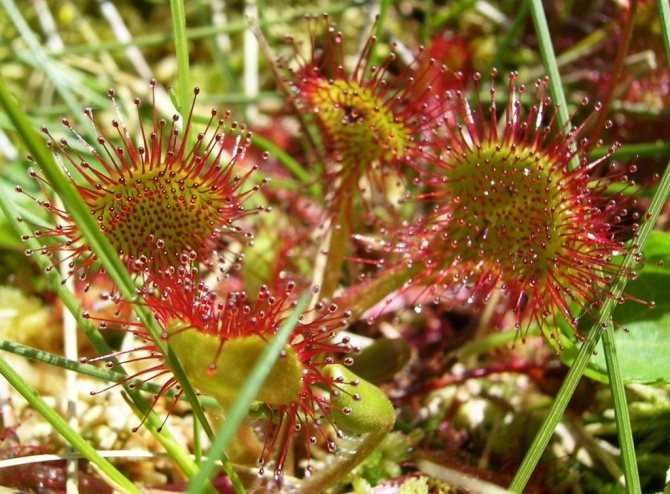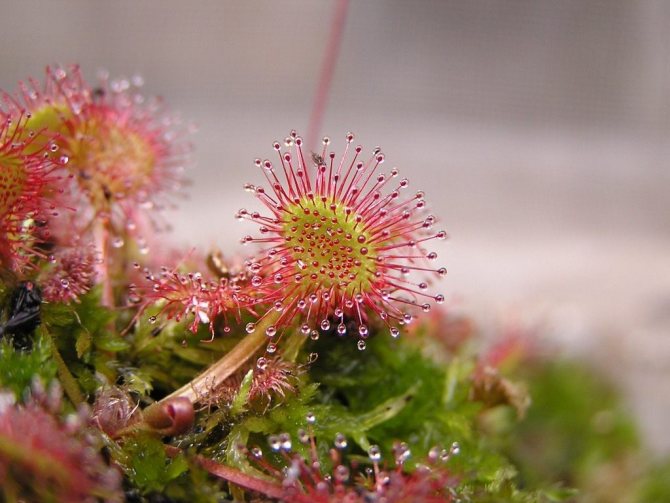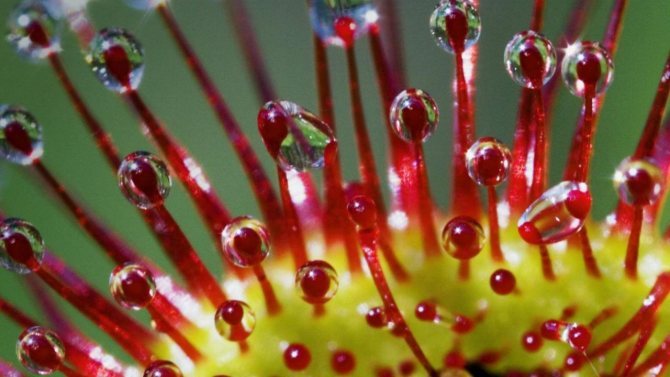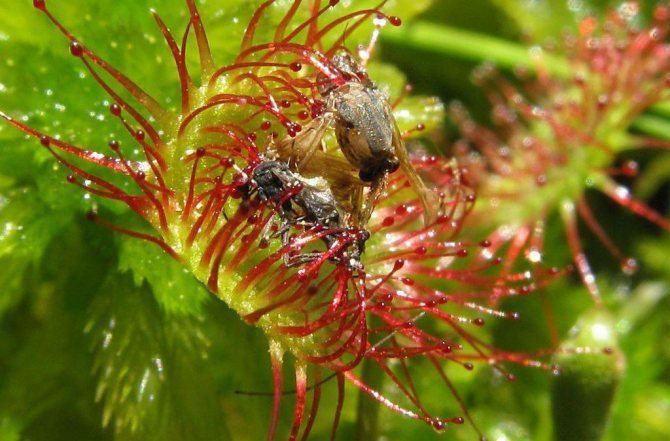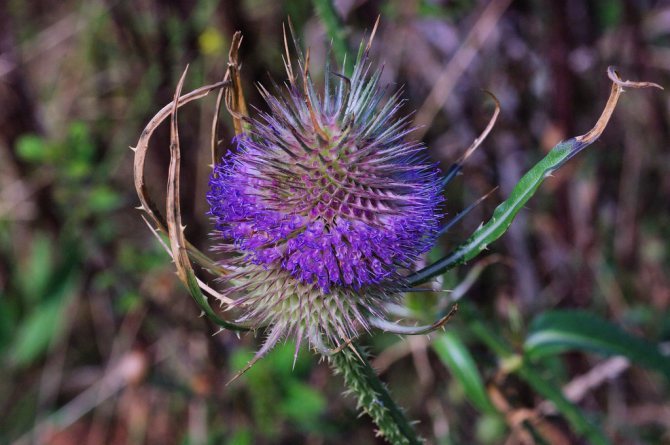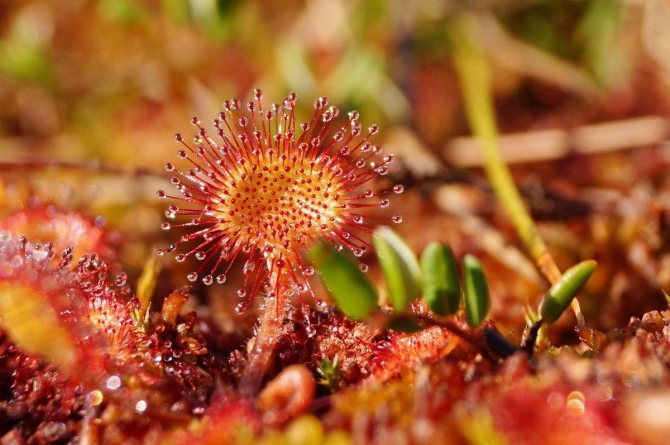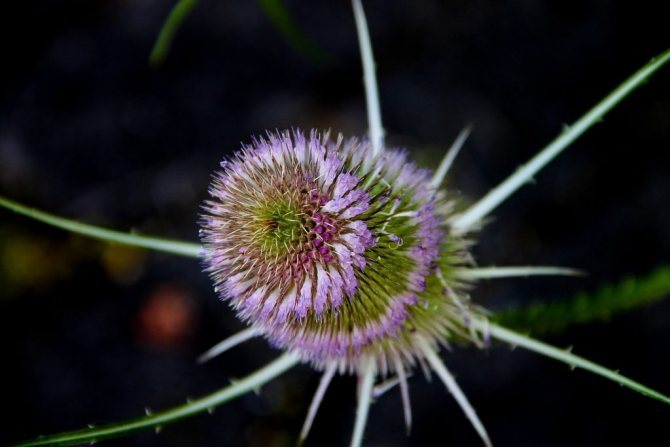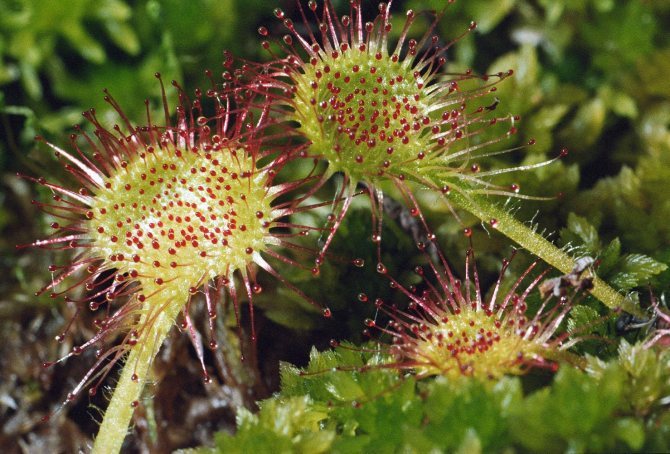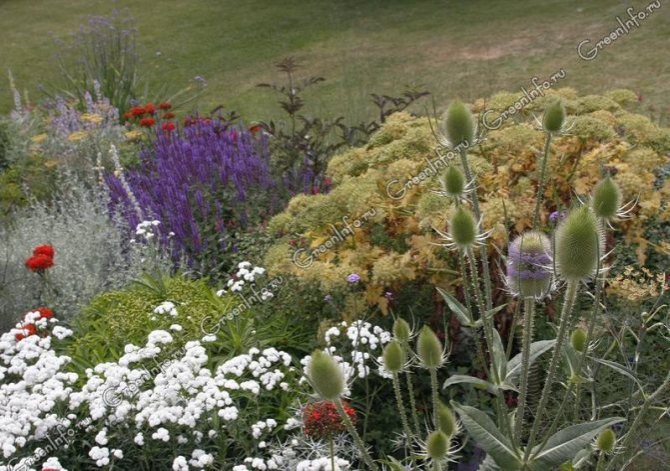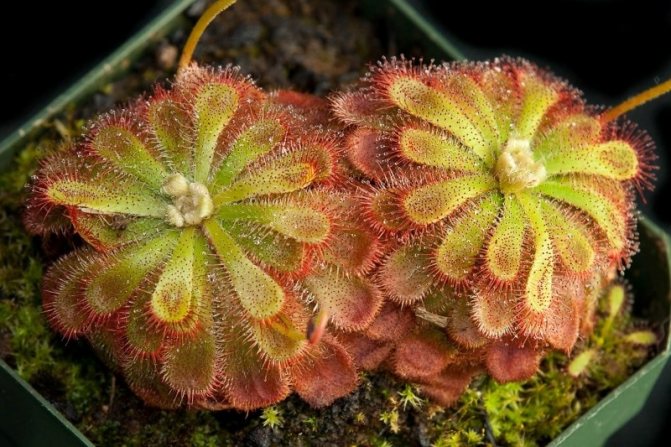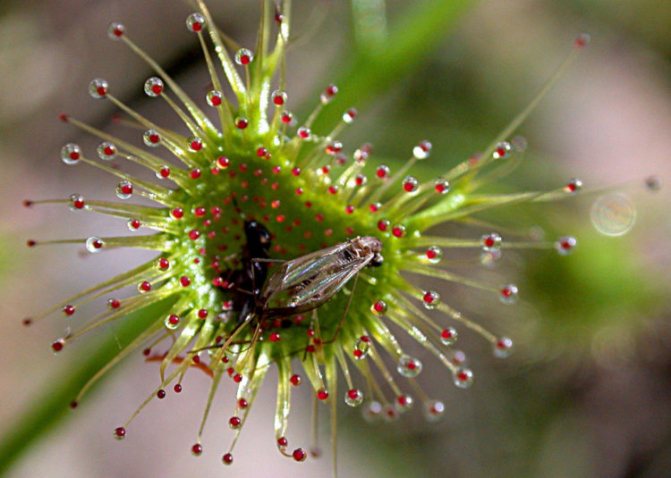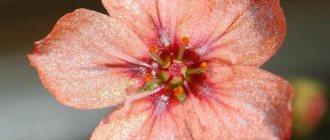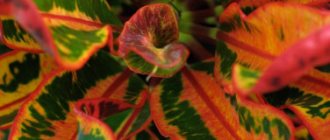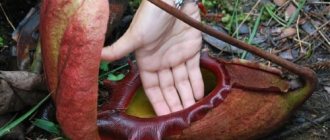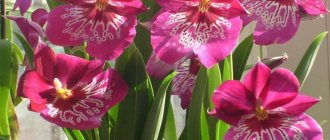Rosyanka is an insectivorous plant of the Rosyankovye family. Another name is Drosera, from Latin it means "dew". In nature, it is found in swampy areas, sandstones, mountains, mainly in Australia, New Zealand. There are 200 species, of which there are those that can withstand wintering under the snow. Others, living in the subtropics, grow all year round.
Life expectancy is 2-10 years. It feeds on mosquitoes, flies, midges, butterflies, beetles. Thanks to this lifestyle, the plant provides itself with nutrition. The flycatcher is also grown at home.
Botanical description

Rosyanka belongs to the Rosyanka family of the same name.
The genus name contains the Greek word "droseros", which means "covered with dew.", because on the glandular hairs of the flower, you can see drops of sticky secretion, reminiscent of morning dew, sparkling in the sun.
The sundew family includes more than 200 species of plants growing in South America, New Zealand, Australia, South America. Several types of sundew are found in the northern hemisphere.
The tropical sundews are much larger than their northern neighbors. For example, the stem of the giant Australian sundew is 1 m long. And the royal sundew, which grows in South Africa, easily digests toads and snails.
Drosera is a perennial insectivorous herb, most often without a stem, but with a creeping rhizome. The root system is well developed, but weak. It is only needed to absorb water and keep the plant on the soil surface.
Rosette basal leaves are covered with reddish hairs, with sticky tips.
By the color of the leaves:
- reddish;
- yellow;
- light green;
- green.
By form:
- small and rounded;
- long, narrow or wide.
The leaves lie on the ground or sit on petioles, the length of which is 2-15 cm.


There are 25 cilia on the upper part of the leaf blade., and the longest are located on the edge.
Sundew blooms in late spring - early summer (2-3 months). The flowers are inconspicuous, small (usually 1.5 cm, but there are species with flowers 4-5 cm in diameter), collected in a brush or panicle. They are located on long peduncles so that pollinating insects do not get trapped. In most species, flowers are only exposed to the sun.
Fruits in the form of a capsule with a large number of small seeds appear in August. When the seeds are fully ripe, the fruit opens into 3 parts, they crumble to the soil and germinate successfully after a year.
About carnivorous plants
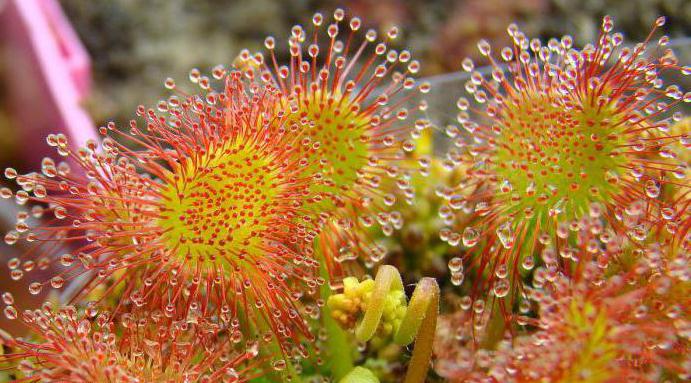

All currently existing carnivorous plants, which are more than 600 species, belong to 19 families, including Rosyankovye. The latter, in particular, includes three genera. Each representative of this group is a perennial herbaceous insectivorous plant, rhizomatous and growing in water or in a swamp. Less common among sundews are dwarf shrubs.
Insectivorous plants became known in the 18th century. An accurate botanical description was first given by the English naturalist D. Ellis in his letter to K. Linnaeus. The object of his observations was the Venus flytrap. It was then that the botanist first made the assumption that insects are food for the plant.
In total, more than a hundred species of the Rosyankovye family are known, and only one representative belongs to the genus Aldrovand and Venus. All the rest belong to the Rosyanka. We will talk about one of them later in the article.
Where does it grow?
The habitat of the sundew is peat bogs of various continents, often growing side by side with shrubs of the heather family.
In the subtropics, the plant grows all year round, whereas in cooler conditions, the flower begins a dormant period and hibernates under a cover of snow. In order to survive severe drought, the members of the family growing on the Australian continent can see an underground thickening of the roots in the form of a tuber, which helps to cope with adverse environmental conditions.
Growing conditions
Growing a sundew indoors is an activity for enthusiasts. Plants are often found on sale, but in order to admire their mysterious splendor, you will need to create certain conditions. Most sundews are evergreens, some retire (in summer or winter). The charming killer will feel best in a plastic or glass terrarium. The depth is required so that the plant protrudes beyond the edges.
How and what does a sundew eat?
The fact that a plant is a predator does not mean that it depends only on receiving live food. After all, if there are no insects, the flower feeds like an ordinary plant.


To catch a prey, the plant first attracts the insect with the sheen of a dew-like droplet, which is actually a sticky digestive enzyme. When the victim touches the leaf, it sticks.
After 10-20 minutes, the cilium, to which the victim stuck, bends to the center of the leaflet. Neighboring cilia also bend, due to which the insect suffocates. At the end of everything, the edge of the sheet plate is bent and the trap is slammed shut. Such a plant reaction occurs only to protein foods., while the flower does not react to other substances.
During the digestion of food, the cilia secrete special enzymes that are similar to pepsin (animal gastric juice). With their help, protein is broken down, due to which the plant dines. When the process is completed, the leaf opens and only the remains of the victim (chitinous membrane) can be seen on it. After that, the cilia straighten, become covered with a sticky secret that resembles dew, and again lure a new victim. Sometimes sundew digestion takes several days.
Favorite delicacy of predatory plants?
Hamsters
Using
Besides the fact that this plant is an excellent honey plant, for which it is especially revered by gardeners, it is also very decorative. Therefore, it is specially grown as a dried flower, which finds its place in dry bouquets, and as a noticeable element that decorates the surrounding landscape.
In landscape design
Amber cones that do not fall in autumn look extremely picturesque against the background of white snow in the winter garden, visibly enlivening the landscape. They look great in winter in the same places of flower beds and lawns where they grew in summer and decorated the area with white, light yellow, purple and lilac inflorescences. Dry bouquets of teasers in garden vases on a white snowy background look very stylish.
In floristry
The cones of this plant are in great demand among florists, who construct from them picturesque dry bouquets and various elegant compositions that adorn the interiors of living quarters and offices.
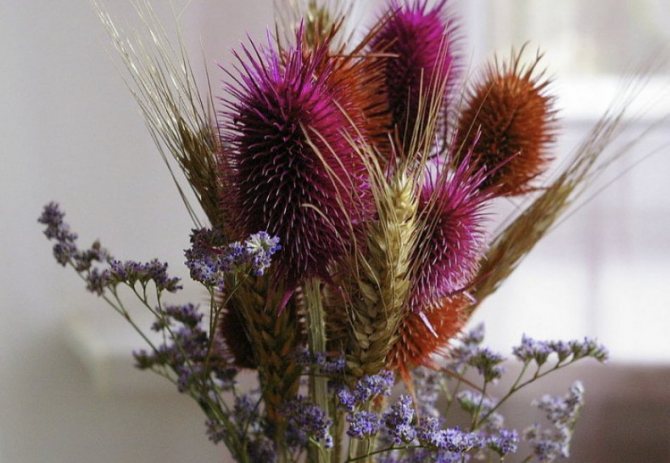

The natural dark amber shade of the teasers bracts is complemented by all sorts of colors that are obtained when painting cones:
- ink;
- watercolors;
- ink;
- food coloring;
- bleaches;
- aniline dyes.
Teasers soaked in brine look very impressive during the New Year holidays, as a result of which they begin to sparkle in the festive lights with salt crystals, as if covered with snow.
Varieties and photos
There is a wide variety of varieties of this exotic predator that thrive in a wide variety of conditions. Below are photos, names and descriptions of sundew varieties suitable for reproduction and care at home:
Round-leaved
This is the most common winter-hardy type of sundew, which is found in peat bogs in the temperate zone of Russia, Asia, America and Europe. When growing a wild specimen in a potted form, the plant must be sure to add the soil in which they grew.


The round-leaved sundew has rounded basal leaves, on which red cilia are located, which secrete sticky mucus.
The stem of the flower reaches 20 cm in length.
The plant blooms in the middle of summer, dissolving small white flowers. The fruits ripen at the end of summer and are a one-nest box. The round-leaved sundew reproduces by seeds, which are collected and sown in greenhouses, laying on the surface of moist peat soil.
To survive the cold season, the plant pre-forms special wintering buds, which are hidden in sphagnum moss. When spring comes, the sun warms up and the snow begins to melt, annual shoots appear from the buds. The photo below shows the Round-leaved Rosyanka:


Cape
This is the most beautiful and unpretentious type of predator, which is most often grown at home. Cape sundew grows all year round, easily adapting to any living conditions.
This plant reaches a height of only 12 cm and is characterized by beautiful, elongated lanceolate leaves of a light green or reddish hue. The leaves sit in a dense rosette and on each of them there are red tentacles with a sticky secret. Cape sundew takes several days to digest food. Peduncles reach 20 cm in height and are crowned with inflorescences of bright pink flowers. What the variety Rosyanka Kapskaya looks like can be seen in the photo below:


English
This type of sundew is common in Ukraine, Belarus, Russia, the Caucasus, Central Asia and the Hawaiian Islands, choosing damp, sandy places and sphagnum swamps.
In height, the English sundew reaches 7-25 cm, the length of thin lanceolate leaves, located on long petioles and directed upwards, reaches 10 cm.The plant blooms in mid-summer, releasing white flowers. The fruit is a unilocular capsule containing grayish-brown seeds. In the photo below, the variety Rosyanka English:


Species features
This pretty grass is found on all types of soil, but more often it can be seen in raised bogs, where there is no soil in the normal sense of the word, but only peat and sphagnum moss. All plants belonging to the genus sundew, including the round-leaved sundew (Drosera rotundifolia l), are insectivorous. The plant got its name from the droplets of a transparent liquid appearing on the thin hairs covering the leaves.


Today, almost one and a half hundred species of sundews are known, and all of them are predators. A similar feature in plants of this genus did not appear at the whim of nature, but because of the need in the most literal sense to get food, since they grow on poor swampy or sandy soils, in which there are practically no nutrients.
Care
Among all predatory plants, sundew is best suited for growing at home, as this plant is easier for beginners to care for. Despite the fact that the flower is picky about lighting and temperature, at home it is possible to create the most suitable conditions for it.For this, the English sundew is best planted in glass vessels or special semi-automatic aquariums. Here the plant will be able to enjoy the high humidity it needs, and will not suffer from changing conditions.
Lighting
Bright lighting is the most important thing when growing sundews, which will not be able to live even with a little shade. But at the same time plants do not tolerate direct sunlighttherefore they should be placed on bright, sunny windowsills with diffused lighting. Artificial lighting alone will not be enough for them, but it is welcomed as an additional lighting.
To compensate for the lack of light in winter, at this time of the year, sundews should be placed on the south windows, and during active growth - on the west or east window.
In winter, the duration of illumination should not be less than 8 hours, and in the spring-summer period - 14 hours.
If the sundew does not have enough light or the lighting is unstable, then the plant will quickly say about it. First signs:
- loss of color;
- changing the texture of the leaves to soft and lethargic.
The leaves should not be allowed to dry out, the faster the sundew illumination normalizes, the better.
Temperature regime
Almost all types of indoor sundews feel good at a temperature of 18-23 ° C. When purchasing a plant, you need to ask in advance what temperature regime the flower is accustomed to. and adhere to these recommendations.


Sundews cannot be grown at the same temperature all year round. During the rest period, it must be reduced to 8-13 ° C, and an increase of more than 14 ° C is unacceptable.
The exception is Alice and Cape sundew, which can tolerate a dormant period in warmth, if the lighting regime does not differ from the summer one. The minimum temperature for heat-loving plants is 7 ° C, and for cold-resistant plants - 2 ° C, but still it is better to avoid a cold snap of less than 8 ° C.
In summer, the plant can be taken out into fresh air., avoiding drafts and protecting from direct sunlight.
Humidity and watering
Sundews are hygrophilous and cannot stand even a short drought. Therefore, it is necessary that the moss and soil contain a sufficient amount of moisture, without drying out even in the middle of the substrate.
It is best to water the flower from below, pouring water into trays, which is drained after a while. Each watering is combined with spraying the soil surface to prevent the top layer of the substrate from drying out.
In the spring-summer period, you need to water the plant once every 3 days, while in winter it is enough to do it once a week, preventing the substrate from drying out.


In regions with high temperature and humidity, sundew can also be grown outdoors.... However, after the rain, you need to drain the excess water from the pot so that the roots do not rot.
Dewdrop feels good only in acidic soil, poor in minerals. To achieve this, you need to use distilled water or rainwater for irrigation. If you use tap water, then you need to collect it in advance and leave it for 1-2 days for the chlorine to settle.
Top dressing
Classic feeding of sundew, like other predatory plants, is not carried out. Additional food for this flower is insects, which can be purchased at pet stores. In summer, plants can be exposed to fresh air, where they will independently attract insects (flies, midges, ants).
If there are no insects in the room, then the standard feeding is 2-3 flies per plant., which is enough to give once a week. In winter, you can rarely feed. 1 time per month. During this period, the plant stops growing, but does not die.
You cannot feed a flower with too large insects. The victim can escape, fly away, and the sheet remains damaged.
Transfer


The sundew is transplanted as needed, when the previous container becomes small for the plant.Moreover, it is best to choose the classic timing of transplantation (February, March), until the flower "wakes up".
For growing sundew, use wide, flat and low containers with drainage holes, no more than 8 cm in height.
Priming
A different type of soil can be used to grow sundew, but the most popular is peat moss (crushed sphagnum moss)... Before using it, be sure to rinse it so as not to cause mold on the plants.
You can also use the following types of soil:
- perlite - a light substrate is used to retain water and allows the roots to grow better (you can mix equal parts of peat and perlite);
- coconut fiber - a peat substitute obtained from the husk of the shell of coconuts (before use, you must thoroughly rinse it from salts);
- aquatic plant soil - consists of small pieces of ceramic chips that absorb moisture well and act like perlite.
Any primer and material that will be used must always be rinsedto get rid of salts and minerals that can damage the plant.
Transfer
Dewdrop is transplanted in early spring, when her winter dormant period ends. The soil is prepared from a mixture of peat, sand and sphagnum moss in approximately equal proportions. Fluff all the components of the mixture well so that the soil is light, loose. When transplanting, try not to crush the soil with your hands too much. The acidity should be pH 4 or lower. The pot should be shallow, with drainage holes in the bottom. Shake off the old substrate completely from the root system. Remove rotten or damaged roots too. The transplant should be repeated every spring due to the fact that the substrate is strongly caked, oxygen stops flowing to the roots, and they gradually die off. If you miss the transplant procedure for a couple of years, the plant will die. With good home care, Rosyanka live long - up to 50 years. After transplanting, dew disappears from the leaves for several days at Rosyanka - this is a normal phenomenon. You can arrange a greenhouse for the flower at this time - cover the pot with a film to maintain a high level of humidity and prevent shock. In a maximum of a week, dew should reappear.
It may be interesting: Rosyanka: description of plant species and varieties
If you have a wide container, then you can plant several instances of Rosyanka in it at once, even of different species, so long as their leaves do not interfere with each other.
Reproduction
Dewdrop is propagated in several ways:
Cuttings
A leaf is cut from the mother plant and kept in moist sphagnum, in a greenhouse. Rooting and the appearance of young sprouts wait 2 months, after which the flower is transplanted into a pot. the cutting can also be rooted in a container of water.
How to grow from seeds?
The collected seeds are poured onto the surface of a mixture of peat and sand, then sprayed. Cover with glass or film and keep 3-5 weeks in bright light and a temperature of + 25 ° С... They dive when four leaves appear.
Dividing the bush
The outlet that goes to the side is separated from the mother liquor and planted in a separate bowl.
Using the tease
The plant has received recognition from both designers and home healers. Its application is multifaceted. Use the entire plant as a whole, including roots, leaves and bracts. Design:
- drawing up one-component and prefabricated bouquets (you will need cones on the peduncle);
- bouquet baskets and gift boxes (green young cones are needed);
- a panel of dried flowers (ripe bracts without flowers or with flowers);
- interior decoration, festive compositions, decorative highlights (cones of different sizes).
Ethnoscience:
Anti-inflammatory and diuretic decoctions for colds or ulcers of the gastrointestinal tract, edema, metabolic disorders. Preparation of the broth: 1 tsp each. Pour 400 ml of water over the crushed roots and leaves of the tease, boil for 20 minutes, leave for about an hour. Take 1 tbsp.6 times a day before meals. The juice has antioxidant properties.
- Relieves inflammation, removes redness after bruises, boils.
- Prevents rashes, relieves itching after insect bites.
- It is used as a pain reliever for rheumatism and gout.
Preparation of the ointment: tease ash (burn a dried whole plant, grind into powder) combine with butter 82.5% (you can homemade). Store in refrigerator for up to 3 months.
Diseases and pests
The sundew is practically not affected by pests, only spider mites and aphids. With a spider mite, Actellik is used. When aphids attack a plant, the flower stops growing, its leaves and stems are deformed.
Diseases on the sundew occur only with improper care:
- Gray rot - first, all affected areas are removed, and then the plant is treated with fungicides.
- Root rot - the stem and leaves turn black, plant growth slows down - caused by low temperatures and waterlogging of the soil. To save the flower, rotten roots are cut off from it, and the plant is transplanted into a disinfected container with new soil.
- There is no sticky secret on the leaves - it occurs when the soil is not suitable and the moisture level is low. This can be corrected by replacing the soil and increasing moisture.
Properties
Now let's find out why the sundew belongs to plants. Its leaves are rich in tannins, ascorbic acid, calcium, fluoroquinols and potassium. It has excellent expectorant properties, therefore, it is used for colds and coughs. In addition, the plant is used to create drugs that have antipyretic, bactericidal and diuretic properties.
Preparations from it are effective in the treatment of respiratory diseases, including bronchitis, whooping cough, tracheitis or laryngitis. Sundew tincture is used for many ailments. In addition, it is used in the treatment of gastrointestinal diseases. It helps reduce asthma attacks.
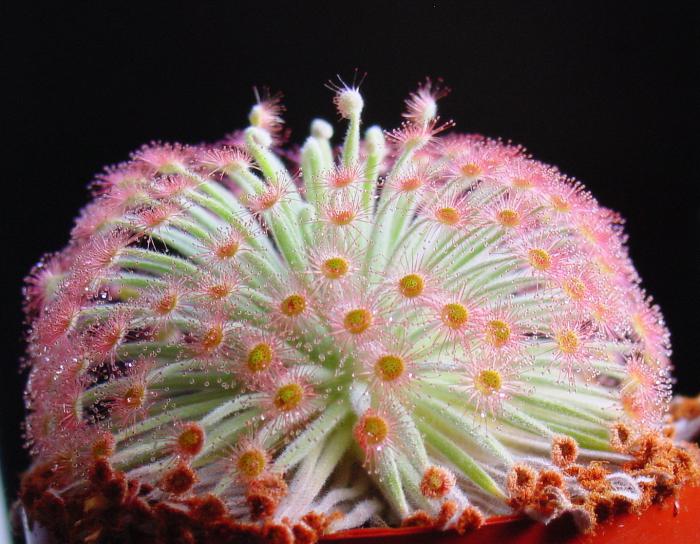

Photo gallery
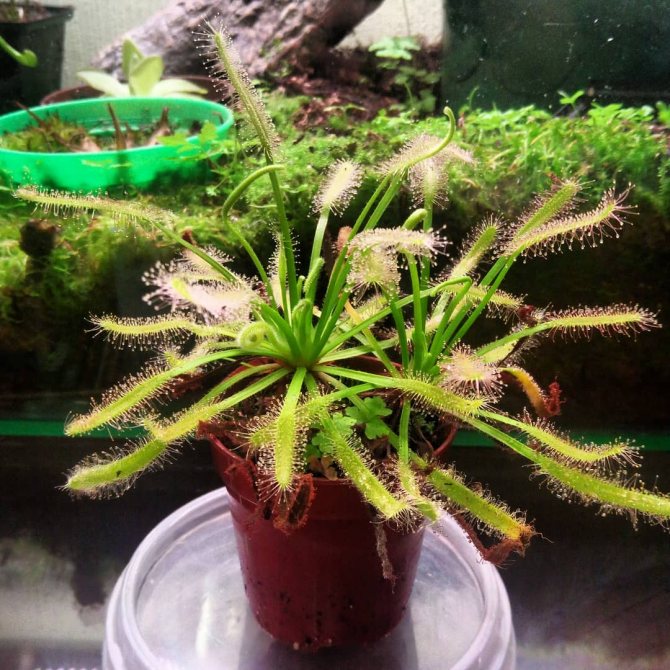

ravenous_house
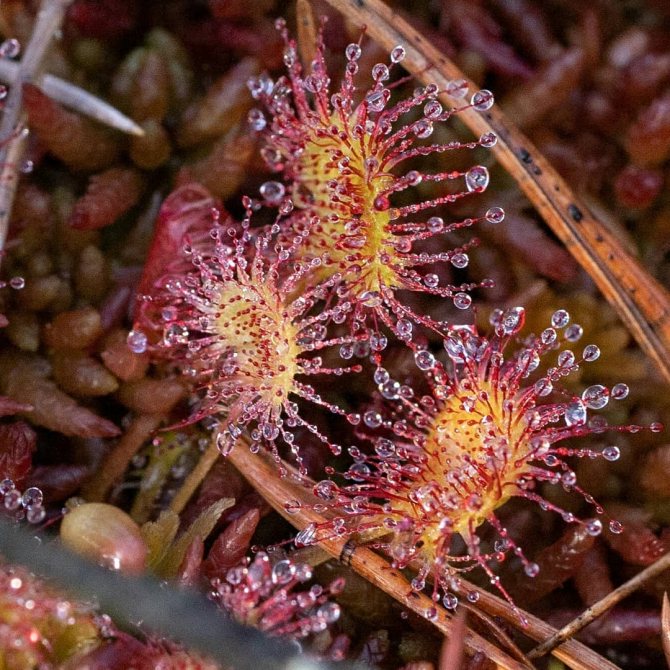

artem_kyznetsv


venerina_muholovka


ravenous_house
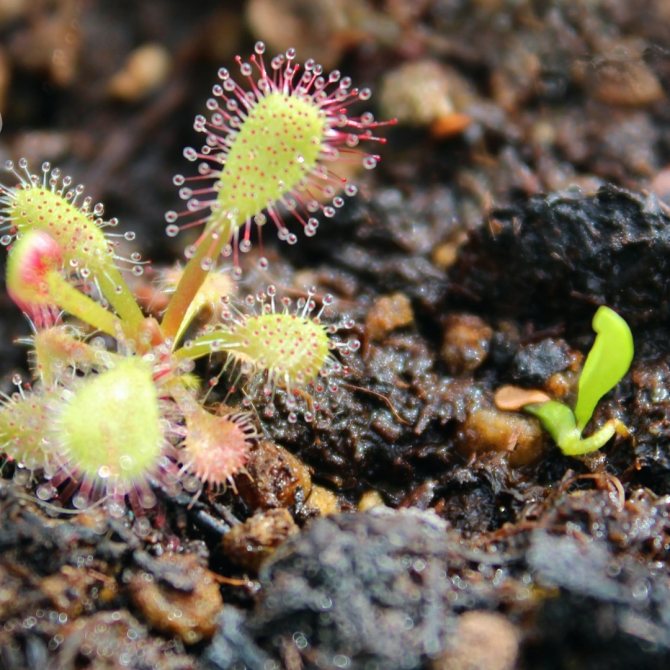

venerina_muholovka
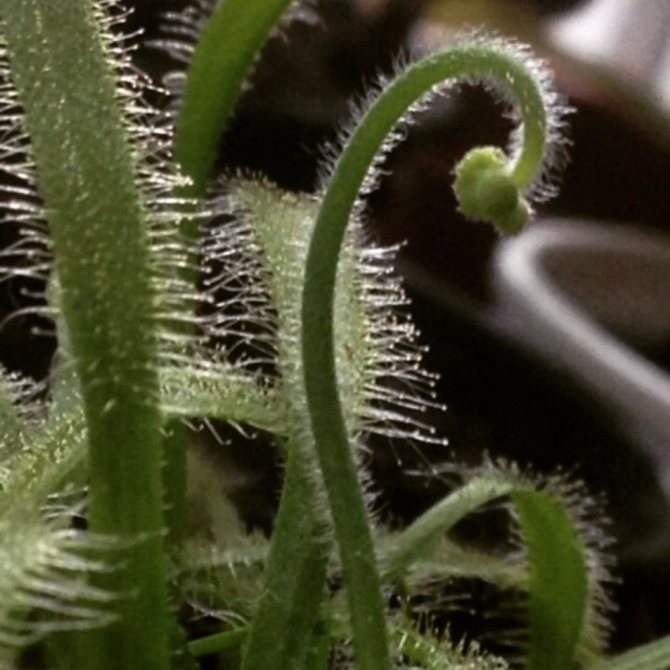

prozerpinah_lmp
The use of sundew in traditional medicine
Due to the huge amount of nutrients that make up the plant, sundew is widely used in traditional medicine and helps fight a huge range of different diseases.
- Decoctions and infusions from the plant are recognized as more effective. They recommend rinsing your mouth to fight dry cough without phlegm.
- Flower-based tea is used internally for the treatment of respiratory viral infections, inflammatory diseases of the upper respiratory tract, whooping cough, tuberculosis.
- Sundew leaf tincture relieves a sharp headache, helps with fever.
- Tincture of common sundew flowers on alcohol is used to combat endarteritis, emphysema, tuberculosis, whooping cough. Its antibacterial properties destroy the favorable habitat of microbes and fungi.
- Due to the huge content of organic and enzymatic substances in the plant sap, homeopaths advise making lotions out of it and putting them on warts and calluses to get rid of them. This procedure helps to restore impaired tissue regeneration, the destruction of various growths. The same remedy is used to remove freckles and dry calluses.
Also read: White lamb in medicine and landscape design

